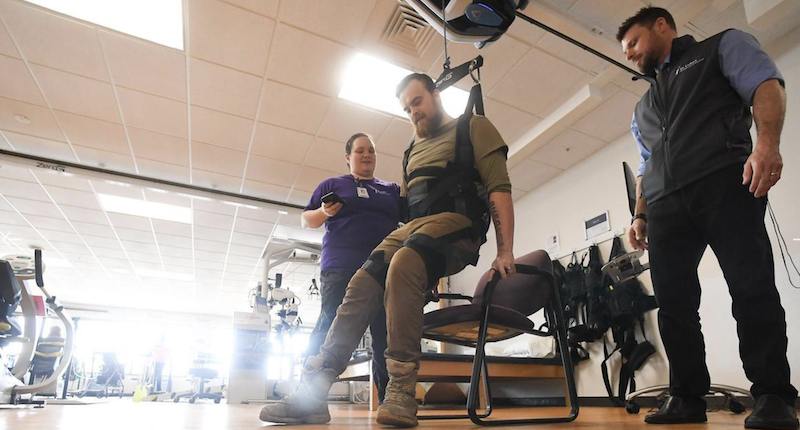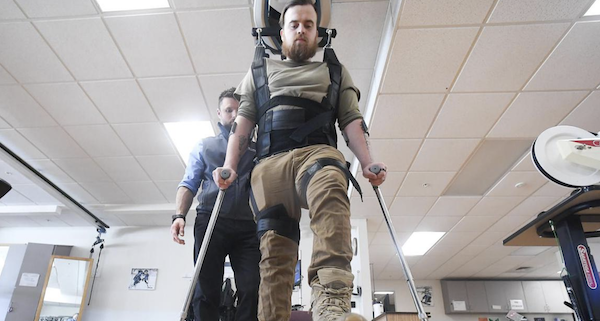No More “Fear of Falling” with the ZeroG Gait and Balance System
Source: Spokesman-Review
After a July 23 rollover accident, Cameron Tweedy received a grim outlook on ever walking again. Along with lower body numbness, he had suffered five fractures in his spine and a crushed ankle.
“They told me I had less than 1% chance of minimal function in my legs,” said Tweedy, 21, a Spokane resident. “I had less than 1% chance of twitching my toes, essentially. I didn’t like that.” He described surgery to repair his spine with pins, rods and a thin metal bar. With therapy, Tweedy now can walk, mostly using crutches. Since early January, he credits a much faster pace to the help of a new device at St. Luke’s Rehabilitation Institute.
Called the ZeroG Gait and Balance System, the robotic body-weight support equipment helps people learn to walk again without fear of falling. The system simulates a reduced-gravity environment. The ZeroG system is expected to help about 1,000 patients a year who have spinal cord and brain injuries, stroke symptoms, multiple sclerosis diagnosis, Parkinson’s disease and lower extremity amputations, St. Luke’s said in a news release.
The device is attached to a motorized trolley along a U-shaped, ceiling-mounted track in a large therapy room. A rope suspends from the ZeroG that is hooked to a harness worn by the patient. As the ZeroG was installed in late December, Tweedy was transitioning from a walker to crutches and had reached about 400 to 600 steps per session. Within a week or two of using the ZeroG, he said it helped him exceed 1,500 steps in one session.
“It’s really hard to go from not walking, and using a walker where you can put all your weight down, to going to crutches,” he said. “I struggled more with walking with that fear of falling, especially with not being able to feel all the lower half of my body. It built my confidence back up. When I started using the ZeroG, that’s when my progression started getting better because the fear of falling went away.”
The robotic device has a sensor as it tracks movements from above, and information is linked to a nearby computer. Therapists also can use a smartphone for monitoring, and software collects data that tracks a patient’s progress and a session’s results. Parameters are set so that the device catches a person before they fall but can allow for some range of motion such as climbing steps. As a patient’s therapy progresses, a wider range can be practiced, such as going from standing to a seated position.

Neurophysical therapist Sarah Gross and Jake Allstot, assistant manager of rehabilitation at St. Luke’s, helped Tweedy go through a recent session. Gross said Tweedy uses the ZeroG once a week in addition to swimming for outpatient therapy.
Allstot said the ZeroG is designed to eliminate the fear of falls because it prevents those from happening, but patients can still feel any loss of balance and the body adjustments needed to compensate if they sense a fall.
“Since we started using it in January, we’ve worked with 32 patients and prevented 250 falls,” Allstot said. “It allows freedom of movement, and it does that with safety at the forefront. “This device allows a patient to really feel his own loss of balance, feel his own weight and do his own performance, but not by compromising safety.” That takes a caregiver’s focus away from watching for falls and instead on providing better therapy treatments, Allstot said. “You can program a fall distance. You can set perhaps 4 inches of fall, or you can set it to where it’s a velocity where it will detect if a patient drops really fast,” he said. “It will stop and correct that fall.”
In earlier therapy sessions, Tweedy had used another piece of equipment at St. Luke’s, the Lokomat, that’s a robotic exoskeleton treadmill. The Lokomat helped him to walk up to nearly 400 steps per session this past fall.
For the recent session, Allstot put the ZeroG’s body harness on Tweedy. The harness attaches to a bar and a rope hovering above a patient’s shoulders. The harness also is secured around the waist, with straps down the thighs and attached around the leg above the knees. During the recent session, Tweedy practiced walking with the use of both crutches. Later, he practiced going over a step, and then walking with one crutch to prepare for eventual use of a cane.
“The way I have it set now is if he drops at certain speed, as soon as he hits that speed, it will catch him,” Allstot said. “The reason we could go over that step is he didn’t exceed a certain velocity.” “The sensor detects how much rope is coming out and how fast. He can go all the way to the ground, and the machine will adapt for that need or for him to sit. It also counts total steps. We can change to a small movement, so if you have a small buckle, it will trigger a response to protect the patient.”
Allstot also demonstrated how the device can help patients practice adjusting their weight and balance in response to someone bumping into them. Tweedy had to shift his balance and at one point put a foot out to catch himself. “You can do a response to simulate a forced pull on him,” Allstot said. “He has to stay balanced. It’s practical if someone in the community bumps into him, and that can happen. He’s practiced for that.”
St. Luke’s also described the ZeroG, which costs $260,000 for equipment and installation, as the only device of its kind in the Inland Northwest. Providence Health Care Foundation provided funds for the system, with major contributors including the Craig H. Neilsen Foundation and the M.J. Murdock Charitable Trust.





Leave a Reply
Want to join the discussion?Feel free to contribute!